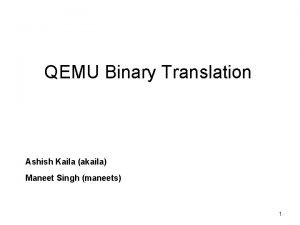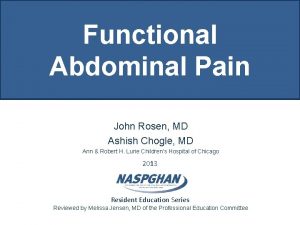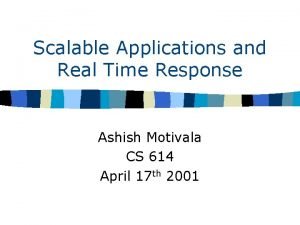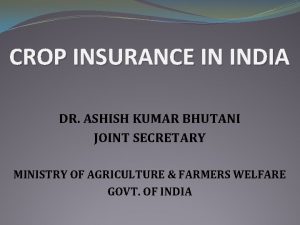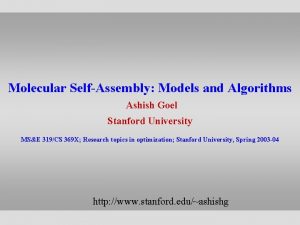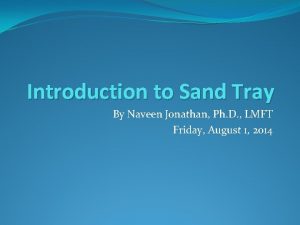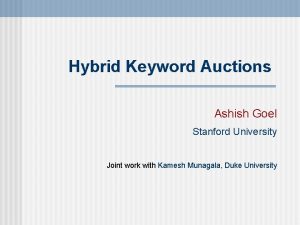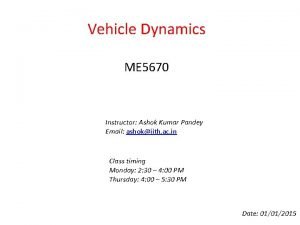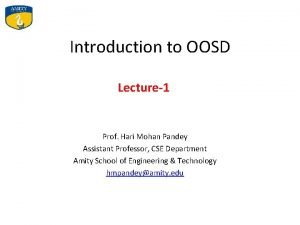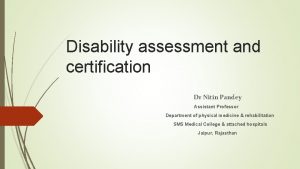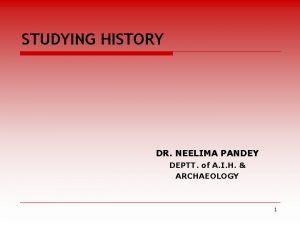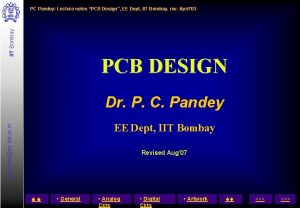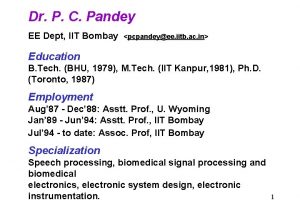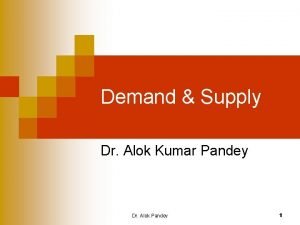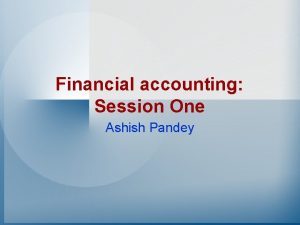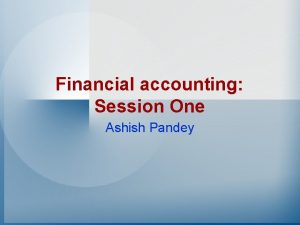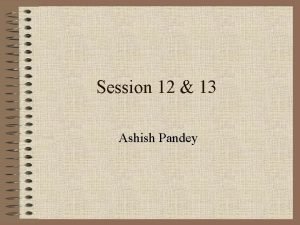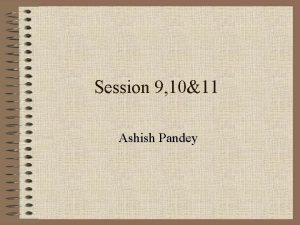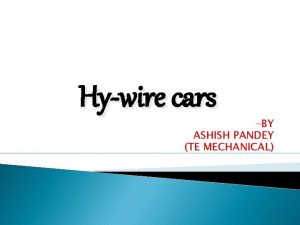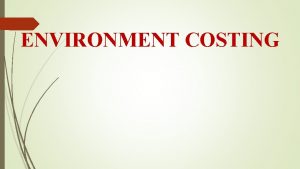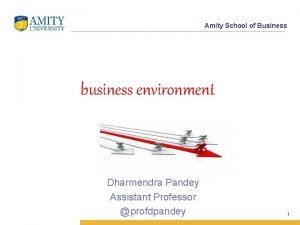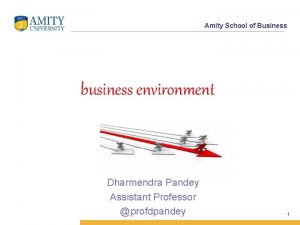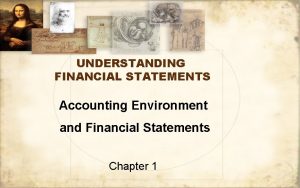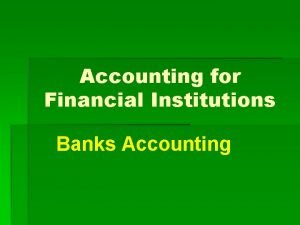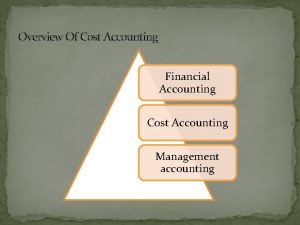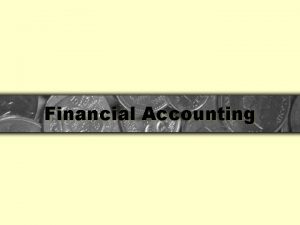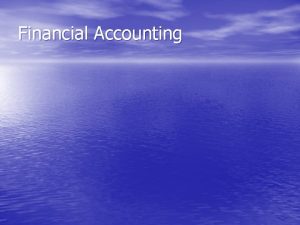Financial accounting Session One Ashish Pandey Accounting environment





























- Slides: 29

Financial accounting: Session One Ashish Pandey

Accounting environment • Ministry of corporate affairs – Administers Companies act 1956 (revised companies act 2013) – Supervises three professional bodies – Imp provisions of the act • Book of a/c to be kept • Financial statements • Compliance with accounting standards • • RBI IRDA SEBI Income Tax Act, 1961

(AS) 2 Valuation of Inventories

Inventories are assets: (a) held for sale in the ordinary course of business; (b) in the process of production for such sale; or (c) in the form of materials or supplies to be consumed in the production process or in the rendering of services.

Measurement of Inventories • Inventories should be valued at the lower of cost and net realisable value.

Cost of Inventories The cost of inventories should comprise all • costs of purchase, • costs of conversion and • other costs incurred in bringing the inventories to their present location and condition.

Cost formulas • The cost of inventories of items that are not ordinarily interchangeable and goods or services produced and segregated for specific projects should be assigned by specific identification of their individual costs

Cost formulas • The cost of inventories, other than those dealt with in previous slide, should be assigned by using the firstin, first-out (FIFO), or weighted average cost formula.

Net realisable value • is the estimated selling price in the ordinary course of business less the estimated costs of completion and the estimated costs necessary to make the sale.

Net Realisable Value The cost of inventories may not be recoverable • if those inventories are damaged, • if they have become wholly or partially obsolete, or • if their selling prices have declined.

Net Realisable value The cost of inventories may also not be recoverable if • the estimated costs of completion or the estimated costs necessary to make the sale have increased. • The practice of writing down inventories below cost to net realisable value is consistent with the view that assets should not be carried in excess of amounts expected to be realised from their sale or use.

Disclosure • The financial statements should disclose: (a) the accounting policies adopted in measuring inventories, including the cost formula used; and (b) the total carrying amount of inventories and its classification appropriate to the enterprise.

Inventory System • Periodic inventory system • Perpetual inventory system

Date transaction units Unit cost Total cost Jan 1 Beginning inventory 100 2 200 Mar 27 Purchase 100 3 300 June 12 Purchase 100 4 400 Sept 19 Purchase 100 5 500 Nov 30 Purchase 100 6 600 total 500 sold 350 Dec 31 Ending inventory 2000 10 3500

Specific identification • Dec 31 inventory constitute of – 60 units from march 27 purchase – 70 units from june 12 purchase – And 20 units from sept 19 purchase • Calculate value of closing inventory under specific identification, fifo, lifo & wac. • Calculate gross profit for all the four inventory costing methods

Effects of FIFO, WAC & LIFO prices Ending inventory Cost of goods sold Gross profit Increasing FIFO>WAC>LIFO>WAC>FIFO>WAC>LIFO Constant FIFO=WAC=LIFO Decreasing LIFO>WAC>FIFO>WAC>LIFO>WAC>FIFO

(AS) 10 Accounting for Fixed Assets

Fixed Assets • It is an asset held with the intention of being used for the purpose of producing or providing goods or services and is not held for sale in the normal course of business. • It comprises a significant portion of the total assets of an enterprise, & therefore are imp in the presentation of financial position.

Component of cost • The cost of an item of fixed asset comprises its purchase price, including import duties and other non-refundable taxes or levies and any directly attributable cost of bringing the asset to its working condition for its intended use; any trade discounts and rebates are deducted in arriving at the purchase price.

directly attributable costs are • site preparation; • initial delivery and handling costs; • installation cost, such as special foundations for plant; and • professional fees, for example fees of architects and engineers.


Non-monetary Consideration • When a fixed asset is acquired in exchange for another asset, its cost is usually determined by reference to the fair market value of the consideration given. • When a fixed asset is acquired in exchange for shares or other securities in the enterprise, it is usually recorded at its fair market value, or the fair market value of the securities issued, whichever is more clearly evident.

Further • Subsequent expenditures related to an item of fixed asset should be added to its book value only if they increase the future benefits from the existing asset beyond its previously assessed standard of performance. • Fixed asset should be eliminated from the financial statements on disposal or when no further benefit is expected from its use and disposal.

EXCEPTIONAL & EXTRAORDINARY ITEMS

Exceptional items • Exceptional item arise from ordinary activity; • They are not expected to be recurring; • the nature and amount of such item is relevant to user of financial statement;

Illustrations of Exceptional items • Profit or loss arises on disposal of fixed asset. • Abnormal losses on long term contract. • Amount received in settlement of insurance claims • Write off of expenditure capitalized on intangible assets other than amortisation.

Extraordinary items • ‘Extraordinary items are income or expenses that arise from events or transactions that are clearly distinct from the ordinary activities of the enterprise and, therefore, are not expected to recur frequently or regularly.

Illustrations of Extraordinary items • Significant charge in Government fiscal policy; • attachment of property, • loss of property due to earthquake/natural calamity.

Exercise • Mamta Fashions Pvt ltd. .
 Financial environment of business
Financial environment of business Ashish ganguly imtech
Ashish ganguly imtech Ashish jain microsoft
Ashish jain microsoft Ashish kachru
Ashish kachru Vmware binary translation
Vmware binary translation Ashish chogle
Ashish chogle Ashish motivala
Ashish motivala Ashish singh parihar
Ashish singh parihar Ashish bajaj fms
Ashish bajaj fms Dr ashish kumar bhutani
Dr ashish kumar bhutani Ashish vaswani
Ashish vaswani Ashish tilethe
Ashish tilethe Naveen jonathan
Naveen jonathan Ashish goel stanford
Ashish goel stanford Ashok kumar pandey iith
Ashok kumar pandey iith Hari mohan pandey
Hari mohan pandey Mannu singh vs umadat pandey case
Mannu singh vs umadat pandey case Dr nitin pandey sms hospital
Dr nitin pandey sms hospital Ryan pandey
Ryan pandey Junagadh rock inscription
Junagadh rock inscription Pc pandey iitb
Pc pandey iitb Pc pandey iitb
Pc pandey iitb Alok
Alok Sophia pandey
Sophia pandey Neonatal progeria
Neonatal progeria Omkant pandey
Omkant pandey Financial accounting and accounting standards chapter 1
Financial accounting and accounting standards chapter 1 Ppt on responsibility accounting
Ppt on responsibility accounting One empire one god one emperor
One empire one god one emperor One one one little dog run
One one one little dog run




